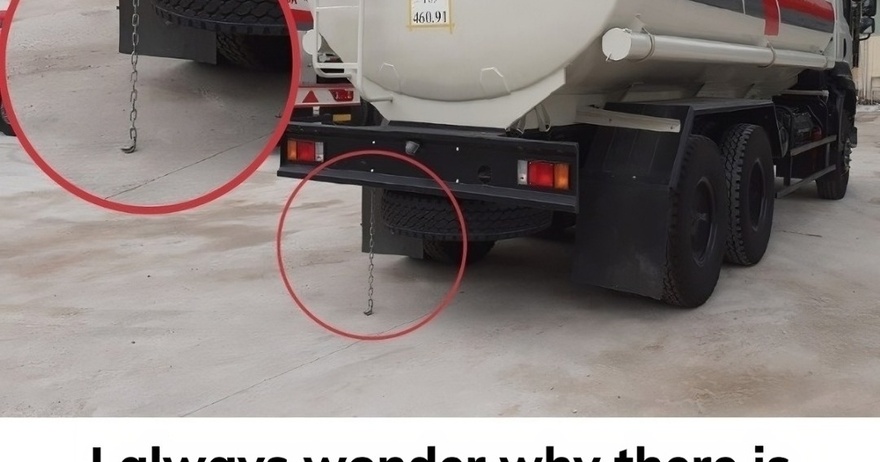If you’ve ever driven behind a tanker truck, you may have noticed a metal chain trailing from the back. At first glance, this dangling chain might seem like an odd feature or perhaps a forgotten tool. However, it’s actually a crucial safety device designed to protect both the truck and its surroundings, especially when transporting flammable liquids like gasoline or oil. So, what role does this chain play, and why is it so vital?
The Role of Static Electricity in Fuel Transport
Before diving into the importance of the chain, let’s explore static electricity and its potential dangers in tanker transport. Static electricity is essentially an imbalance of electric charge, often caused by friction. When a tanker truck moves, the liquid inside sloshes around, causing friction between the fuel, air, and the interior walls of the tank. This interaction leads to a build-up of static electricity.
How Static Electricity Forms: As the tanker moves, flammable liquids like gasoline rub against the tank’s metal surface, producing static charges.
The Risk of Ignition: Without proper grounding, static charges can release as sparks, which could ignite the flammable materials inside the tank, creating a hazardous situation.
How Chains Help Ground Tanker Trucks
To prevent sparks from occurring, tanker trucks use a grounding system—this is where the trailing chain comes into play. The chain serves as a grounding tool, safely discharging static electricity to the earth.
Conductivity: The metal chain has high conductivity, allowing it to absorb the static charge.
Neutralization: As the chain drags on the ground, it transfers the static electricity from the truck to the earth, neutralizing the charge and reducing the risk of accidental sparks.
By continuously grounding the tanker truck, the chain minimizes the chances of fire or explosion, making it an essential feature for safely transporting flammable materials.
Static Electricity: A Hazard at Every Stage of Fuel Transport
Static electricity is not just a concern while the truck is moving. It can also build up when the tanker is stationary, particularly during fuel loading or unloading. During these processes, the liquid’s movement inside the tank generates friction, which, in turn, causes static build-up.
Discharge During Fuel Transfer: When fuel is pumped in or out of the tanker, friction can create a significant amount of static electricity. If not grounded, this electricity can discharge as sparks.
Specialized Grounding Systems: Many tankers are equipped with additional grounding devices, such as the Road Tanker Grounding (RTR) system, which provides a reliable grounding path during fuel transfers.
Other Grounding Technologies for Tanker Trucks
While chains are a common grounding method, there are other advanced systems to enhance safety:
Static Dissipaters: These devices release static charges gradually, helping reduce overall build-up. They add an extra layer of protection by keeping static levels lower.
Grounding Cables: Some trucks use grounding cables that connect the truck directly to the ground during loading or unloading, ensuring a more direct discharge of static electricity.
Conductive Tires: A less common feature, some trucks have conductive tires that allow minor static charges to discharge through the tires. However, this is often used alongside other grounding measures since it’s not fully effective on its own.
Why Not All Tanker Trucks Have Chains
If grounding chains are so crucial, why don’t all tanker trucks have them? The answer depends on the type of cargo and the regulations in place:
Non-Flammable Cargo: Trucks carrying non-flammable liquids like water or milk don’t require the same grounding measures since there’s no risk of ignition.
Advanced Grounding Systems: Some modern tankers are equipped with more sophisticated grounding systems that make chains unnecessary.
Regional Regulations: Safety requirements for grounding can vary by region. In some areas, chains are mandated, while others may allow alternative grounding methods.
Understanding the Science of Grounding
So, why is grounding so effective? When static electricity accumulates on a tanker’s surface, grounding provides a pathway for these electrical charges to move to the earth, achieving electrical neutrality. By allowing electrons to flow away from the tanker, the chain prevents a dangerous charge imbalance that could lead to sparks.
Conclusion: Safety First with a Simple Chain
In the fuel transportation industry, safety measures are of utmost importance. The trailing chain on a tanker truck might look insignificant, but it plays a pivotal role in preventing catastrophic accidents. By grounding the truck, it significantly reduces the risk of ignition and explosions, keeping the driver, cargo, and public safe.
While newer grounding technologies offer additional safety measures, the metal chain remains a reliable, cost-effective, and time-tested solution. So, the next time you see one of these chains dragging behind a tanker truck, remember—it’s not just a quirky addition; it’s a critical safety feature that’s saving lives.






























